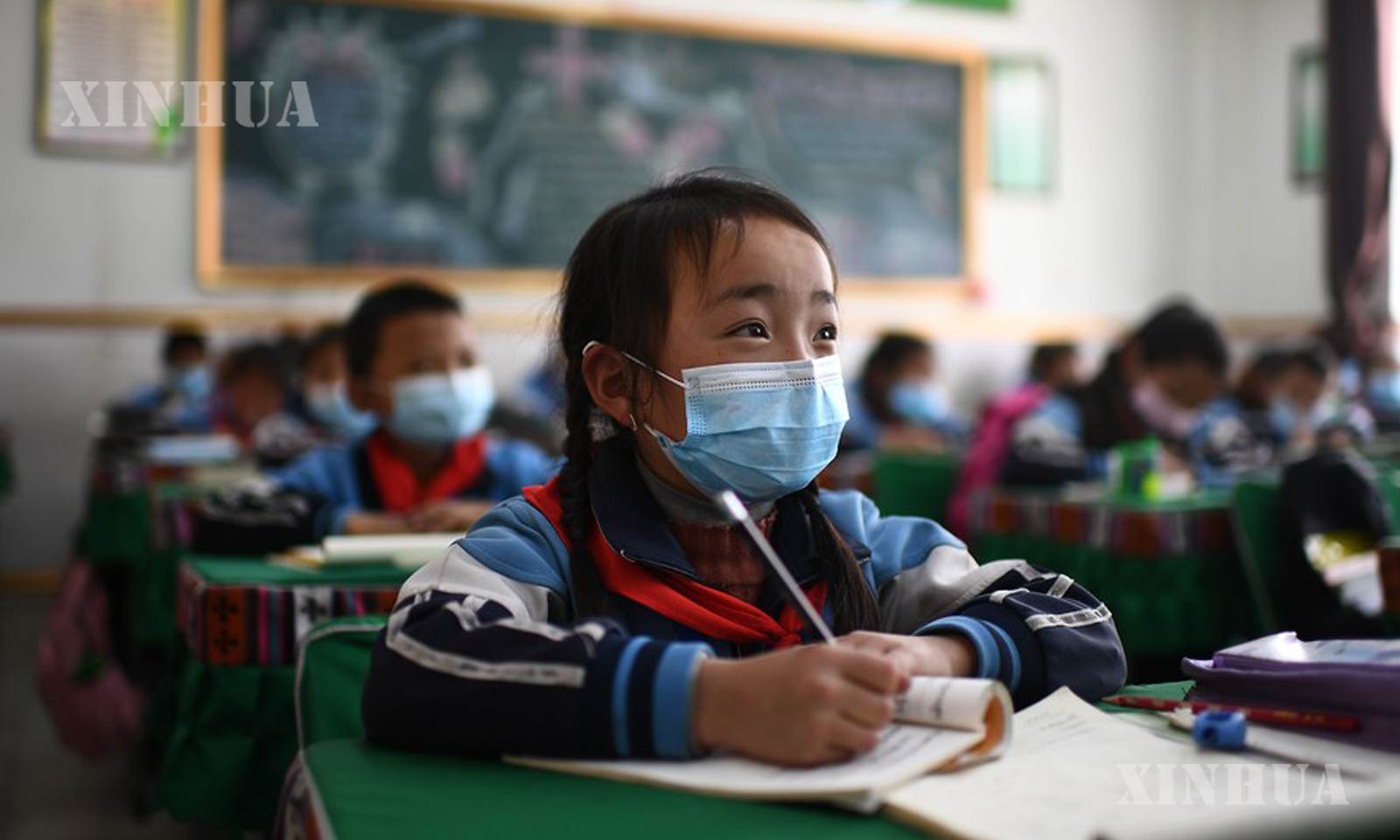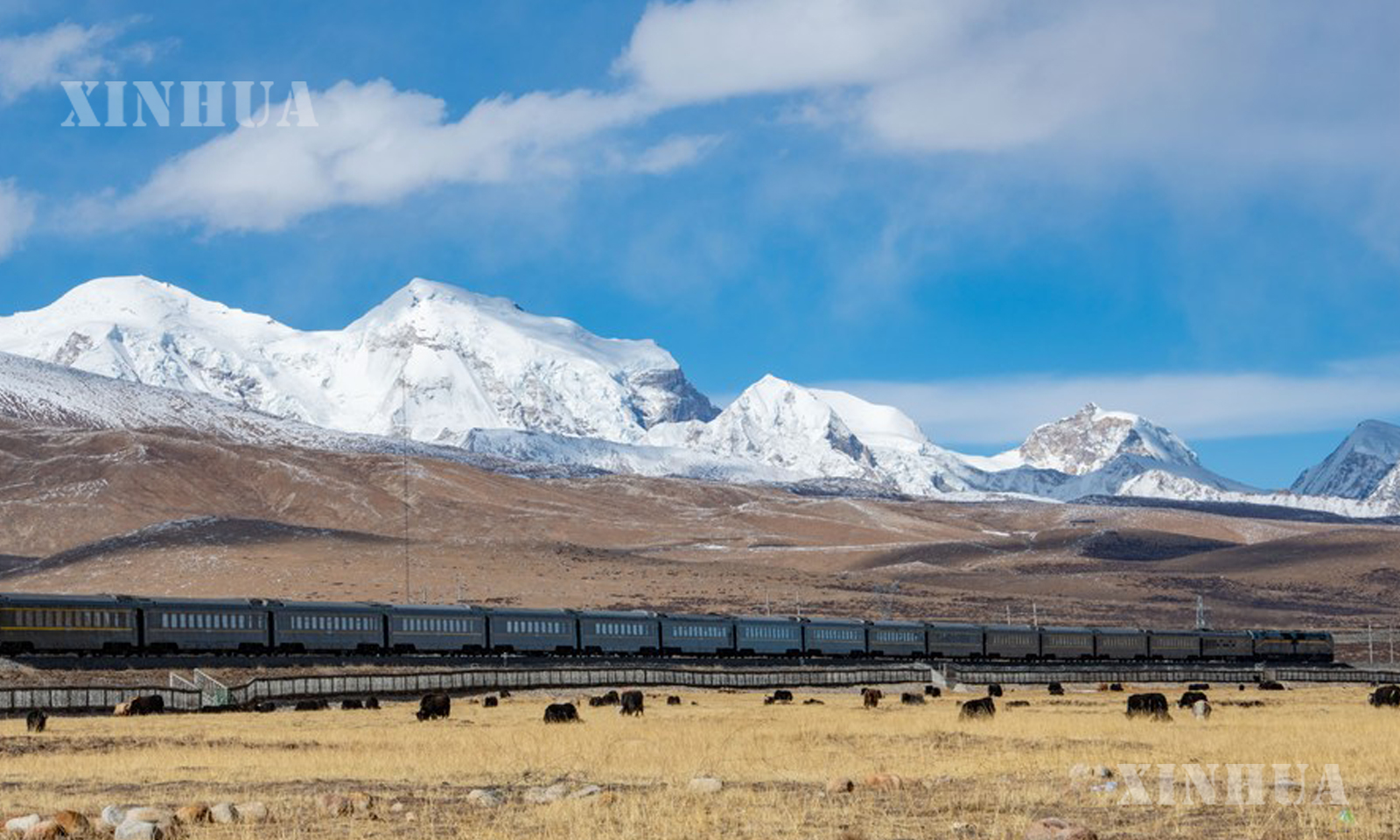Social, Education & Health
ကုန်းမြင့်ဒေသတွင် နေထိုင်သူများက ပညာရေးနှင့် မြို့ပြလူနေမှုဘဝကို တန်ဖိုးထားလာ

ရှီနင်း၊ ဧပြီ ၁၉ ရက် (ဆင်ဟွာ)
ချောင်စူးကျွမ်း ၏ နေအိမ်အသစ်လေးမှာ သူ(မ) ၏ စာသင်ကျောင်းမှ ၂ ကီလိုမီတာခန့်သာ ကွာဝေးသည်။ အသက် ၁၂ နှစ်အရွယ် အဆိုပါ မိန်းကလေးငယ်၏ မိသားစုက ကျေးရွာဟောင်း၌ပင် ဆက်လက်နေထိုင်ပါက ကျောင်းသို့သွားရာ လမ်းခရီးမှာ ကီလိုမီတာ ၆၀ ခန့် ရှိမည်ဖြစ်သည်။ချောင်၏ ဇာတိသည် တရုတ်နိုင်ငံ အနောက်မြောက်ပိုင်း ချင်းဟိုင်ပြည်နယ် ဟိုင်တုန်းမြို့ရှိ မင်ဟယ် ဟွေလူမျိုးနှင့် ထူလူမျိုး ကိုယ်ပိုင်အုပ်ချုပ်ခွင့်ရခရိုင်၊ မင်ကျူကျေးရွာဖြစ်ပြီး ပျမ်းမျှအားဖြင့် ပင်လယ်ရေမျက်နှာပြင်အထက် မီတာ ၄,၀၀၀ ကျော်တွင် တည်ရှိသည်။ ယခုအခါ ၎င်းတို့သည် ယင်းကောင်တီအတွင်းရှိ မြို့ပြဧရိယာတစ်ခုသို့ ပြောင်းရွှေ့ခဲ့ကြပြီး ပိုမိုအဆင်ပြေသော ဘဝ၌ နေထိုင်လျက်ရှိသည်။
“ကျွန်တော့်ကလေးတွေအတွက် ပိုမိုကောင်းမွန်တဲ့ ပညာရေးကို ပေးချင်ခဲ့တာပါ။ ဒါကြောင့် မိသားစုအနေနဲ့ ဒီနယ်မြေထဲက ဘယ်နေရာမှာပဲဖြစ်ဖြစ် အိမ်တစ်လုံးလောက်ဝယ်ဖို့ ဆုံးဖြတ်ခဲ့ကြတာ” ဟု ဖခင်ဖြစ်သူ ချောင်မန့်စိန် က ပြောခဲ့သည်။

တရုတ်နိုင်ငံ အနောက်မြောက်ပိုင်း တိဘက် ကိုယ်ပိုင်အုပ်ချုပ်ခွင့်ရဒေသရှိ Nyainqentanglha Range ဖြင့် ချင်းဟိုင်-တိဘက်ရထားလမ်းပေါ်၌ရထားတစ်စင်းပြေးဆွဲနေသည်ကို ၂၀၂၀ ပြည့်နှစ် မတ် ၁ ရက်က တွေ့ရစဉ် (ဆင်ဟွာ)
ဖခင် ချောင်သည် ကျေးရွာရှိ ၎င်း၏ လယ်ယာကို အငှားချထားခြင်းဖြင့် အကျိုးအမြတ်ရရှိသလို မြို့ပေါ်၌ ဈေးဆိုင်ငယ်လေးတစ်ခုကို လုပ်ကိုင်လျက်ရှိသည်။ “အရင်က ကျွန်တော်တို့ ကောက်ပဲသီးနှံတွေစိုက်ပျိုးခဲ့သော အခုဆိုရင် ဝင်ငွေတွေများလာပြီပေါ့” ဟု ၎င်းက ဆိုသည်။
ချင်းဟိုင်-တိဘက်ကုန်းပြင်မြင့် အရှေ့ပိုင်းတွင် တည်ရှိသော ဟိုင်တုန်းမြို့တွင် စိုက်ပျိုးမြေ ဟက်တာ ၂၀၀,၀၀၀ နီးပါးရှိပြီး တစ်ဦးလျှင် ပျမ်းမျှဧရိယာ ၀.၂ ဟက်တာလုပ်ကိုင်လျက်ရှိကြောင်း သိရသည်။
ပြောင်းရွှေ့နေထိုင်ရခြင်းမှာ ကလေးငယ်များ၏ ပညာရေးဟူသော အဓိက အကြောင်းရင်းဖြင့် မကြာသေးမီနှစ်များစွာက မြို့များ သို့မဟုတ် မြို့ကြီးများသို့ အခြေချနေထိုင်လျက်ရှိသော ကျေးရွာသူ၊ ကျေးရွာသား အရေအတွက်မှာ တိုးပွားလာကြောင်း ဟိုင်တုန်းမြို့၊ ယန်ကျားကျေးရွာ တာဝန်ရှိသူ ယွမ်ဖုတယ်က ပြောကြားခဲ့သည်။
အဆိုပါ အခြေအနေမှာ ကျေးလက်ဧရိယာတွင်လည်း အလားတူပင်ဖြစ်သည်။
ယွိစု တိဘက်ကိုယ်ပိုင်အုပ်ချုပ်ခွင့်ရပြည်နယ်ခွဲ၊ လိုင်ယန်ကျေးရွာမှ တိရစ္ဆာန်ထိန်းကျောင်းသူ ထန်ကျန့်သည် လက်ရှိတွင် မြို့ပေါ်တွင်ကျောင်းတက်နေသော ကျေးရွာမှ ကလေးငယ် ၁၃ ဦးကို စောင့်ရှောက်နေသူဖြစ်သည်။
လိုင်ယန်ကျေးရွာရှိ အိမ်ထောင်စု ၁၆ ခုမှ နွားကျောင်းသမားများသည် ၎င်းတို့၏ ကလေးငယ်များအတွက် မြို့ပေါ်တွင် တစ်ထပ်အိမ်လေးများ စုပေါင်းဆောက်လုပ်ခဲ့ကြသည်။ ၎င်းတို့အနက် အချို့မှာ မြို့၌ပင် ကလေးငယ်များကို စောင့်ရှောက်နေကြပြီး အချို့မှာမူ ကျေးရွာ၌ပင် နေထိုင်လျက် သိုးများနှင့် ကျွဲ၊နွား တိရစ္ဆာန်များကို ထိန်းကျောင်းလျက်ရှိကာ အခြားသူများမှာမူ သိုးသားနှင့် အမဲသား ထုတ်လုပ်ခြင်းနှင့် ရောင်းချခြင်းလုပ်ငန်း၌ ပါဝင်နေကြကြောင်း သိရသည်။
“အရင်တုန်းကတော့ ရွာက ကလေးတွေက မိသားစုရဲ့ တိရစ္ဆာန်မွေးမြူရေးလုပ်ငန်းတွင် ကူညီလုပ်ကိုင်ရန် အလွန်ငယ်ရွယ်သောအချိန်၌ ကျောင်းထွက်ခဲ့ကြရတယ်။ ဒါပေမဲ့ အခုတော့ လူတွေက နောက်မျိုးဆက်တွေအတွက် ပညာရေးက အရေးပါတယ်ဆိုတာကို သိနားလည်လာကြပြီး မြို့ကြီး မြို့ငယ်တွေက ကျောင်းတွေဆီကို ပို့ကြတယ်။ ပြီးတော့ သူတို့လည်း ကလေးတွေကို ပြုစုစောင့်ရှောက်ဖို့ အဲဒီကို ပြောင်းရွှေ့သွားကြတယ်” ဟု ထန်ကျန့်က ပြောခဲ့သည်။
သားသမီးများ၏ ပညာရေးအတွက် မြို့ကြီး၊ မြို့ငယ်များသို့ ရွှေ့ပြောင်းနေထိုင်ကြသော တောင်တန်းဒေသတွေက ရွာသူရွာသား အရေအတွက် များပြားလာလျက်ရှိပြီး ကုန်းပြင်မြင့်ရှိ မြို့ပြပုံစံမှာလည်း ပြောင်းလဲလာခဲ့ပြီဖြစ်ကြောင်း ဒေသခံအများစု မြို့ပြသို့ ပြောင်းရွှေ့သွားကြသည်ကို မြင်တွေ့နေရသော ဟိုင်တုံမြို့၊ ယောင်ကျွမ်းကျေးရွာ၊ ပါတီအကြီးအကဲ လျူချွမ်းယွမ်က ဆိုသည်။
၂၀၂၀ ပြည့်နှစ် နှစ်ကုန်ပိုင်တွင် ပြုစုထားသော သန်းခေါင်စာရင်းအချက်အလက်အရ ချင်းဟိုင်ပြည်နယ် မြို့ပြလူဦးရေမှာ ၃.၅ သန်းကျော်ရှိပြီး မြို့ပြ၌အမြဲနေထိုင်မှုနှုန်းမှာ ၆၀ ရာခိုင်နှုန်းရှိကြောင်း၊ လွန်ခဲ့သော ဆယ်စုနှစ်တစ်ခုအကြာက ကိန်းဂဏန်းနှင့် နှိုင်းယှဉ်ပါက ၄၁ ရာခိုင်နှုန်းနှင့် ၁၅ ရာခိုင်နှုန်း အသီးသီးမြင့်တက်လာခြင်းဖြစ်ကြောင်း၊ ပြည်နယ်၏ မြို့ပြပုံစံပြောင်းလဲမှု၏ လျင်မြန်သောဖွံ့ဖြိုးတိုးတက်မှုကို ရောင်ပြန်ဟပ်ခြင်းလည်း ဖြစ်သည်။
ကျေးလက်ဒေသခံများက မြို့ကြီး၊ မြို့ငယ်များထံ ရွှေ့ပြောင်းနေထိုင်ကြသော်လည်း ကျေးလက်ဒေသ၌ နေထိုင်သူများအနေဖြင့်လည်း အခွင့်အလမ်းသစ်များ မြင်တွေ့နေရကြောင်း သိရသည်။
“ဒီမှာ လစ်လပ်သွားတဲ့ လယ်မြေတွေအများကြီးရှိနေတယ်။ ဒါကြောင့် ကျွန်တော် မြေငှားပြီး သိုးမွေးမြူရေးကို ကျယ်ကျယ်ပြန့်ပြန့် စတင်လုပ်ကိုင်နေပါတယ်” ဟု ရှဲ့ရှားကျေးရွာ ကျောက်လုံဖာက ပြောခဲ့သည်။
ဝေဝမ်းဟုန်ဟု အမည်ရသော ကျေးရွာသားတစ်ဦးကလည်း မြေ ဟက်တာ ၁၀၀ ခန့်ကို ငှားရမ်းကာ အာလူးများ စိုက်ပျိုးခြင်း၊ မြက်များ၊ မုယောများနှင့် ပဲများ စိုက်ပျိုးလုပ်ကိုင်လျက်ရှိသည်။
“မနှစ်က ကျွန်တော် ယွမ် ၂၀၀,၀၀၀ ကျော် (အမေရိကန်ဒေါ်လာ ၃၁,၃၉၁ ခန့်) ဝင်ငွေရှိခဲ့တယ်” ဟု ဝေက ဆိုပြီး အနာဂတ်တွင် ဟင်းသီးဟင်းရွက်များ ပိုမိုစိုက်ပျိုးနိုင်ရန်နှင့် စိုက်ပျိုးမြေများ ချဲ့ထွင်ခြင်းနှင့် အစားအသောက်စက်ရုံ ဖွင့်လှစ်ရန် လယ်မြေတိုးချဲ့ရန် စီစဉ်ထားကြောင်း ဖြည့်စွက်ပြောခဲ့သည်။
စိုက်ပျိုးရေးကို ပမာဏာများပြားစွာ လုပ်ကိုင်ရန် ဦးစားပေးထားသော ဝေသည် ထောက်ပံ့သယ်ပို့လုပ်ငန်းကို ပင်ပန်းစွာလုပ်ကိုင်နေရသည့် ရွှေ့ပြောင်းအလုပ်သမားတစ်ဦးဖြစ်ကာ နှစ်စဉ် ယွမ် ၆၀,၀၀၀ ခန့်သာ ဝင်ငွေရရှိခဲ့ခြင်းဖြစ်သည်။ (Xinhua)
———————–
(English Version)
Across China: Plateau residents value education, urbanization
2022-04-18 17:00:48 Category:Society
XINING, April 18 (Xinhua) — Qiao Shujuan’s new home is just 2 km from her school. If the 12-year-old girl’s family was still living in their old village, that journey to school would be around 60 km.
Qiao’s hometown is Minzhu Village, Minhe Hui and Tu Autonomous County, in the city of Haidong, northwest China’s Qinghai Province, where the average altitude is more than 4,000 meters. Now they have moved to an urban area within the same county, making life much easier.
“We wanted to provide better education for our children, so the family decided to buy a house elsewhere in the county,” said Qiao Mingsheng, the father.
The senior Qiao receives dividends by leasing his farmland in the village and runs a small shop in town. “We get a bigger income now than we got by planting crops in the past,” he said.
Sitting in the east of Qinghai-Tibet Plateau, the city of Haidong has nearly 200,000 hectares of cultivated land, making an average per capita area of 0.2 hectares.
Yuan Fude, a village official of Yangjia Village in Haidong, said an increasing number of villagers have settled down in towns or cities in recent years, with children’s education being the main reason for moving.
The situation is similar in the pastoral area.
Tazang, a herdsman from Laiyang Village, Yushu Tibetan Autonomous Prefecture, is now taking care of 13 children from the village who are attending schools in the town.
Herders from 16 households in Laiyang Village set up a cooperative and built bungalows for their children in the town. Some of them take care of the children in the town, some stay and graze sheep and cattle in the village, and others take part in the processing and selling of mutton and beef.
“In the past, children in the village dropped out of school at a very young age in order to help their families graze livestock. But now, more people attach importance to education for their next generation and send their children to schools in cities and towns. They also move there to take care of their children,” said Tazang.
An increasing number of villagers deep in the mountains are moving to cities and towns for their children’s education, which has also changed the pattern of urbanization on the plateau, said Liu Changyuan, Party chief of Haidong’s Yaozhuang Village, which has seen the majority of residents move to the town.
Census data shows that, by the end of 2020, the urban population of Qinghai Province was over 3.5 million, and the urbanization rate of permanent residence hit 60 percent, increasing by 41 percent and 15 percentage points, respectively, compared with the figure for a decade ago, which reflected the rapid development of the province’s urbanization.
Although rural residents are flocking to cities and towns, those staying in the rural areas also see new opportunities.
“There is a lot of vacant farmland, so I rented land and started to develop sheep breeding on a large scale,” said Zhao Longfa, a villager in Xiexia Village.
A villager named Wei Wenhong also rents around 100 hectares of land to grow potatoes, forage grass, oats and beans.
“I earned more than 200,000 yuan (about 31,391 U.S. dollars) last year,” Wei said, adding that he plans to expand the land to grow more vegetables and open a starch factory in the future.
Prior to engaging in agriculture on a large scale, Wei used to be a migrant worker, toiling in logistics, with an income of only around 60,000 yuan every year. Enditem
Photo 1 : A student takes a class at a primary school in Yushu City, Yushu Tibetan Autonomous Prefecture, northwest China’s Qinghai Province, April 9, 2020. (Xinhua/Zhang Hongxiang)
Photo 2 : A train running on the Qinghai-Tibet Railway passes by the Nyainqentanglha Range in southwest China’s Tibet Autonomous Region, March 1, 2020. (Xinhua/Purbu Zhaxi)






